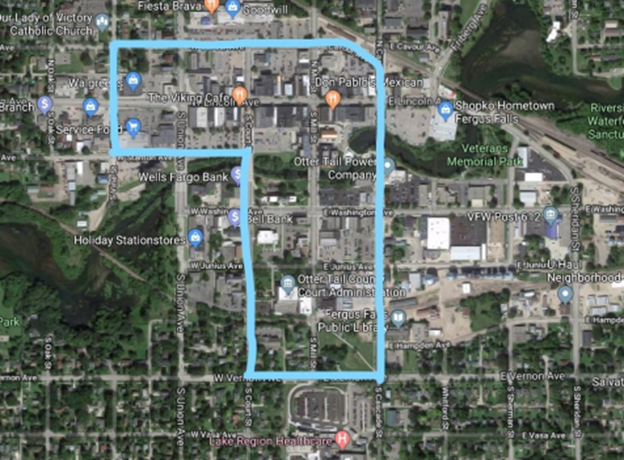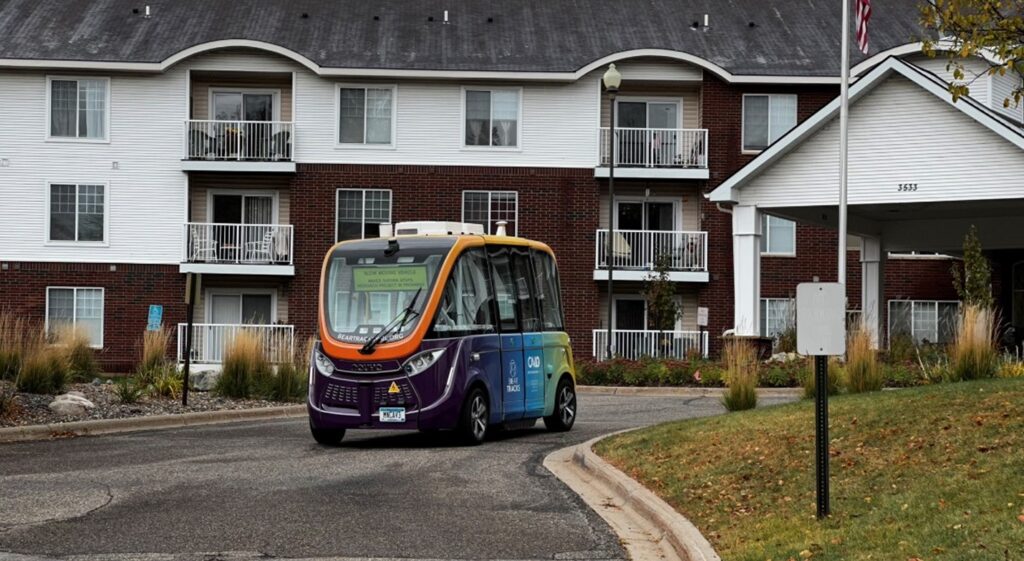Rapid advancements in transportation technologies such as AVs present a major challenge and unprecedented opportunity to enhance safety and mobility. Beyond mitigation of congestion, injury, or death caused by human error, AVs offer restored mobility to those limited by age and/or disability. Lacking the ability to drive or access to a vehicle can severely harm economic and social opportunities, and that harm will become more widespread as America’s population ages.[i] Reduced mobility of this sort is predominantly concentrated in rural communities, which account for a large and growing share of the aging population and often require lengthier commutes to reach both essential and community services.[ii]
Project Purpose
Recognizing the potential of AVs to assist mobility-limited community members, a research team from the University of Minnesota’s Roadway Safety Institute approached a few communities in Minnesota to conduct an AV demonstration. Conducting a demonstration requires presenting a demonstration plan in accordance with local laws, making note of potential hazards, the proposed vehicle, route scheduling and logistics, and cost. Sponsored by U.S. DOT, the research team approached communities not to introduce the shuttles directly, but to explain the potential benefits and offer their expertise and support in facilitating the process for those interested. They ultimately were successful in entering agreements with Fergus Falls (pop ~14,000) and White Bear Lake (pop ~24,000). The proposed routes were 1.8 and 1.5 miles respectively, avoiding left turns and (with one exception in White Bear Lake) signalized intersections. Proposed alternate destinations and routes were adopted following community input.[iii] The Fergus Falls proposed route is seen below.

The proposed AV route in Fergus Falls following community input. Such routes can visit residences, community centers, public libraries, supermarkets, and other locations. Source: University of Minnesota Center for Transportation Studies, 2019
Outcomes
The most significant lesson from collaborating with the two communities was the importance of engaging and involving local stakeholders. In Fergus Falls, the research team found an ally in City Engineer Brian Yavarow, who facilitated a first meeting with the City Council and served as liaison. Yavarow’s involvement was critical to the team having quick and informed feedback on their ideas, but working exclusively with city staff kept the project within its academic boundaries.[iv] The outcome in White Bear Lake, by contrast, showed the momentum that can build from a broader coalition of stakeholders. A member of the local Chamber of Commerce (now retired) championed the project to several other community leaders, raising interest and awareness that proved critical in bringing in outside support. This saw a growing role for a community-based transit manager, a review of liability insurance and other potential requirements by a local consulting firm, and additional funding through a MnDOT grant program.[v] Winning over community firms and leaders and allowing them to win over each other activated pre-existing networks, turning White Bear Lake into a model for early AV action.
The proposed route has evolved into Bear Tracks, a free, “low speed (10-12 mph), self-driving, electric, multi-passenger shuttle” for up to ten passengers at a time, pictured below.[vi] The shuttle’s onboard safety attendant is trained to address vehicular and passenger emergencies. The shuttle’s sensors will gather data to fill gaps in information and inform future usage of AV technology in other communities.[vii]

The Bear Tracks self-driving shuttle in operation. Source: Bear Tracks, 2022
There is an informative comparison of the results in Fergus Falls, where the initiative ended with the conclusion of the study, and in White Bear Lake, where the study helped plant the seed for the current shuttle demonstration. Community engagement and enthusiasm are powerful assets in introducing an AV shuttle route, and likely with any public-facing use of driverless vehicle technology. Public trust in new technology is built on common understanding and familiarity, and AVs are largely unfamiliar. Polling from the AARP suggested 79% of baby boomers were afraid to ride in an AV in 2018, with 71% considering it unsafe to share the road with one.[viii] Yet the shuttles used in demonstrations are often slow-moving and built for caution that is beyond that of human drivers.[ix] Because of their existing networks and ties, community leaders and stakeholders become essential allies in communicating the safety data collected from previous demonstrations and the potential benefits with the public. The UMN research team looked to existing AV demonstration plans and laws as of June 2019 to create a series of questions, demonstrating to interested communities both a judicious concern for safety and the steps required to create a plan best tailored to their specific needs.[x]
In any community, it will be essential to develop a plan acceptable to local law and with complete information about potential hindrances posed by adverse weather or unclearly marked roadways. The community has multiple options to acquire the shuttle, able to purchase one outright, contract a transit management provider, or lease a vehicle while managing its operations—with each option requiring access to vehicle charging infrastructure and the presence of one or more on-board safety operators prepared to manually assume control in response to a vehicular or passenger emergency.
For more information, the Roadway Safety Institute’s website can be found at http://www.roadwaysafety.umn.edu. Additional information on the Bear Tracks shuttle and contact information for involved parties can be found at https://beartrackswbl.org.
[i] Vespa, J. (2018). “The Graying of America: More Older Adults Than Kids by 2035.” United States Census Bureau, https://www.census.gov/library/stories/2018/03/graying-america.html
[ii] Oberdorfer, E. & Wiley, K. (2014). “Housing an Aging Rural America: Rural Seniors and Their Homes.” Housing Assistance Council, https://ruralhome.org/wp-content/uploads/storage/documents/publications/rrreports/ruralseniors2014.pdf
[iii] Douma, F. & Petersen, E. (2019). “Scenarios and Justification for Automated Vehicle Demonstration in Rural Minnesota.” University of Minnesota Center for Transportation Studies, https://www.cts.umn.edu/publications/report/scenarios-and-justification-for-automated-vehicle-demonstration-in-rural-minnesota
[iv] Personal communication with Frank Douma, June 2022
[v] Personal communication with Frank Douma, June 2022
[vi] “Hop On Board MnDOT’s Destination CAV White Bear Lake Self-Driving Shuttle!” https://beartrackswbl.org
[vii] Bartkey, J. (2022). “MnDOT launches Bear Tracks automated shuttle project in White Bear Lake.” Minnesota Department of Transportation, https://www.dot.state.mn.us/news/2022/08/05-statewide-launches-bear-tracks.html
[viii] Kiger, P. (2018). “Boomers Think Autonomous Vehicles Are Unsafe.” AARP, https://www.aarp.org/auto/driver-safety/info-2018/self-driving-vehicles-unsafe.html
[ix] Beene, R. (2017). “Robot Vehicles Are Overly Cautious Drivers.” Government Technology, https://www.govtech.com/transportation/robot-vehicles-are-overly-cautious-drivers.html
[x] Douma, F. & Petersen, E. (2019). “Scenarios and Justification for Automated Vehicle Demonstration in Rural Minnesota.” University of Minnesota Center for Transportation Studies, https://www.cts.umn.edu/publications/report/scenarios-and-justification-for-automated-vehicle-demonstration-in-rural-minnesota
This report was delivered to the U.S. Department of Transportation in 2023. It was primarily authored by NADO Associate Director Carrie Kissel and NADO Research Fellow Danny Tomares. Many transportation agency staff and others assisted with this project in a variety of ways. We offer deep and heartfelt thanks to all the individuals who have provided information and images, consented to be interviewed, and offered editorial guidance in support of this research. Any opinions, findings and conclusions, or recommendations expressed in this publication are those of the authors and do not necessarily reflect the views of U.S. DOT or the NADO Research Foundation.
To read more about the NADO Research Foundation’s ITS case studies, follow this link.


